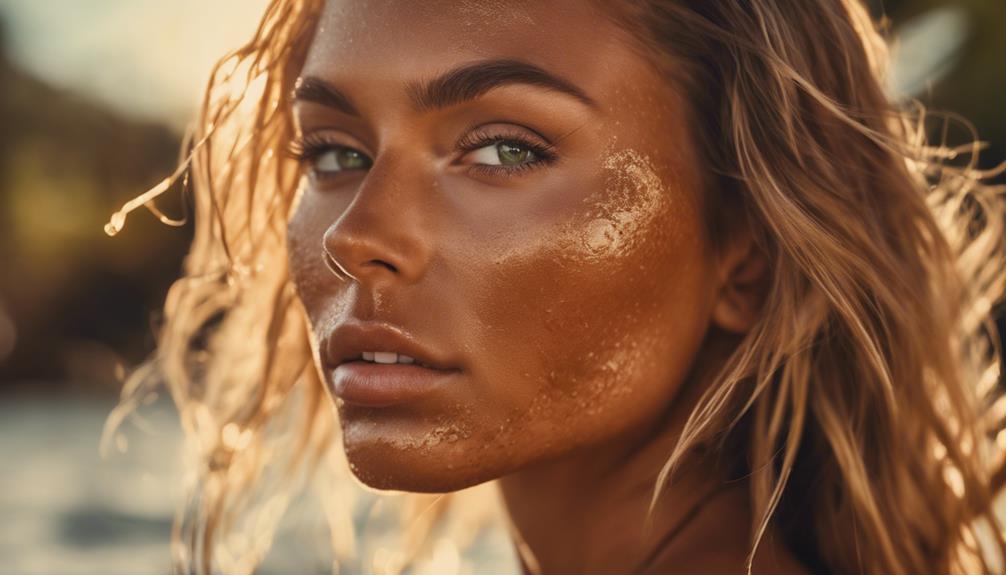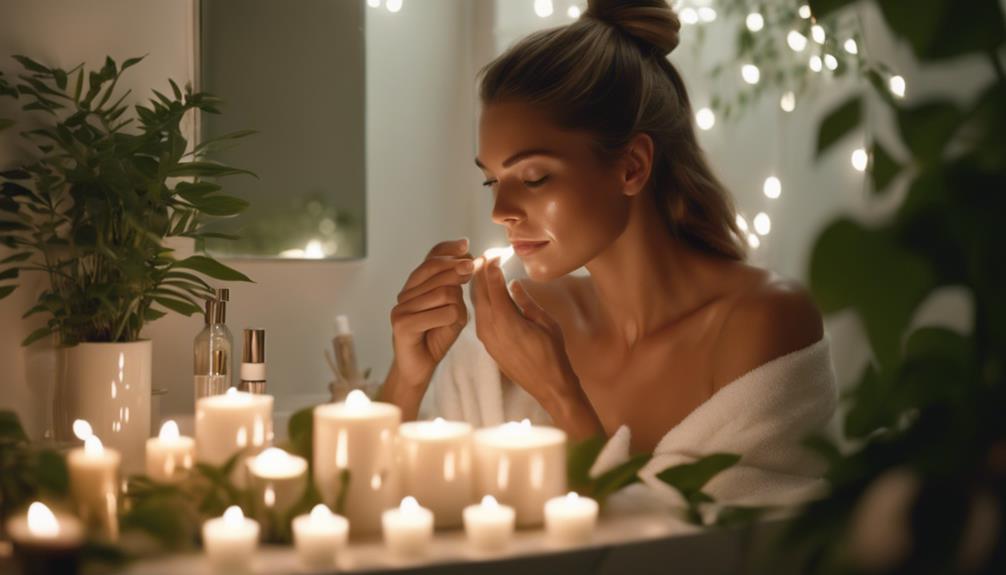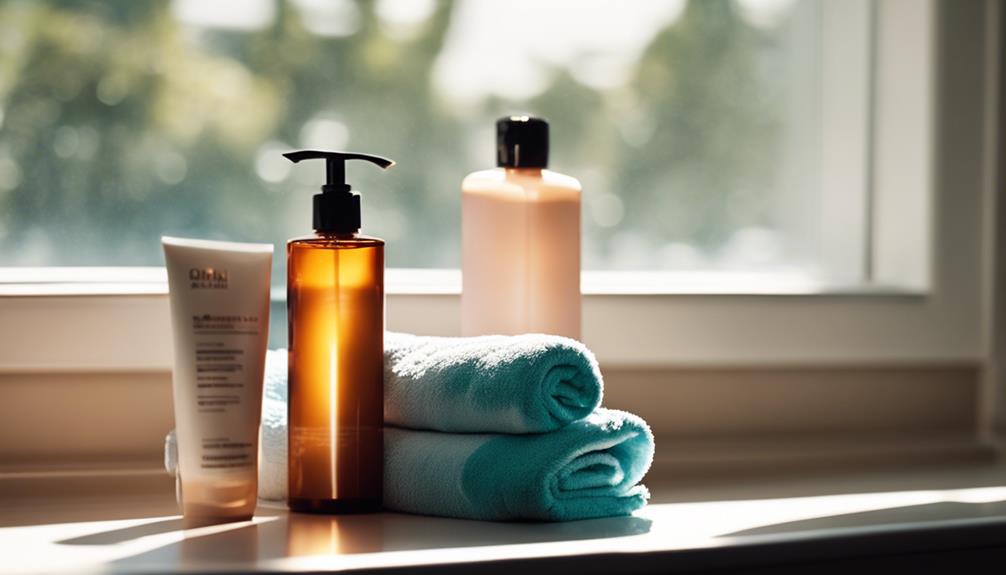Pre-tan moisturizing is your golden ticket to achieving that radiant, salon-quality tan! Think of it as prepping your canvas before painting—hydrating your skin creates the perfect base for an even and lasting glow. Choose a lightweight moisturizer if you've got oily skin, or a rich cream if you're on the drier side. Don't forget to apply your moisturizer the night before and again on tanning day for maximum hydration. Keep it up even after tanning to maintain that gorgeous color. Trust me, your skin will thank you! Stick around to discover more tips and tricks to elevate your tanning game! Hydrate your skin for tanning by drinking plenty of water and incorporating hydrating foods into your diet. Avoiding harsh exfoliants and hot showers can also help maintain your skin’s moisture levels. Remember, the key to a beautiful tan is healthy, well-hydrated skin. So, don’t skip the moisturizing step in your tanning routine!
Key Takeaways
- Hydrating your skin with the right moisturizer creates a smooth base for a radiant and even tan.
- Choosing a moisturizer suitable for your skin type enhances tan longevity and skin health.
- Apply a rich moisturizer the night before tanning for optimal hydration and results.
- Consistent daily moisturizing before and after tanning maintains your glow and prevents patchiness.
Benefits of Pre-Tan Moisturizing
Pre-tan moisturizing sets you up for success by hydrating your skin, ensuring an even and lasting tan. When your skin's well-hydrated, it creates the perfect canvas for that sun-kissed glow.
Think of it like prepping a delicious cake; you wouldn't skip the mixing, right? Proper hydration helps your tan last longer and prevents patchiness, so you won't look like you've got a bad sunburn!
Plus, daily moisturizing keeps your skin feeling soft and smooth, making your tan pop even more. And let's face it, nobody wants to look like a dried raisin!
Choosing the Right Moisturizer

Selecting the right moisturizer is essential for achieving a flawless tan and keeping your skin in top condition.
You want a product that hydrates without feeling greasy, so look for lightweight, non-comedogenic options if you have oily skin.
If your skin tends to be dry, go for something rich and creamy that will lock in moisture.
Got sensitive skin? Stick with fragrance-free, gentle formulas to avoid irritation.
And if you're dealing with combination skin, you might need to mix and match!
Remember, the right moisturizer not only preps your skin for tanning but also helps your glow last longer.
Timing Your Moisturizing Routine

Timing your moisturizing routine is essential for achieving the best tanning results and ensuring your skin stays hydrated. You want to get it just right!
Here's how to time it perfectly:
- Night Before Tanning: Apply a rich moisturizer to maximize hydration overnight.
- Morning of the Tan: Moisturize again, but let it soak in for at least 15-30 minutes before tanning.
- Post-Tan Care: Keep moisturizing daily to maintain that gorgeous glow and even fading.
- Consistency is Key: Stick to your routine, as regular moisturizing enhances your tan's longevity.
Customizing for Skin Types

Customizing your moisturizing routine based on your skin type is essential for achieving the best tanning results.
If you've got oily skin, go for lightweight, non-comedogenic moisturizers that won't clog your pores.
For those with dry skin, you'll want rich, creamy products that feel like a big hug for your skin!
Sensitive skin? Stick to fragrance-free, gentle formulas that treat your skin like royalty.
And if you have combination skin, don't be shy—mix and match products to cater to different areas.
Remember, what works for one person mightn't work for you, so tune in to your skin's needs.
With the right moisturizer, you'll be well on your way to that sun-kissed glow!
Tanning Equipment Considerations

When it comes to achieving the perfect tan, having the right tanning equipment is essential for ensuring a flawless application and impressive results. You don't want to end up looking like a zebra, right?
Here are a few key considerations when choosing your tanning gear:
- Spray Tan Machines: High-quality machines provide an even spray, giving you that salon finish.
- Airbrush Systems: These allow you to customize your tan's intensity and coverage, perfect for those tricky spots.
- Portable Options: If you're mobile, look for lightweight equipment that's easy to carry.
- UV Protection: Always grab protective eyewear to shield your eyes from any harmful rays.
With the right tools, you're well on your way to that sun-kissed glow!
Safe Tanning Practices

With the right tanning equipment in hand, you can enhance your sun-kissed look while prioritizing safe tanning practices to protect your skin.
First off, always wear protective eyewear—your eyes will thank you later! Next, limit your UV exposure to avoid that lobster-red look; nobody wants to be mistaken for a crab at the beach.
Also, give your skin a little love by moisturizing before and after your tanning session. This keeps your skin hydrated and helps your tan last longer.
If you're using a tanning bed, make sure to assess your skin type to find the perfect settings.
Exploring Healthy Tanning Options

Exploring healthy tanning options can help you achieve that sun-kissed glow without the risks associated with UV exposure. You don't have to bake in the sun or squeeze into a tanning bed!
Here are some fun ways to get that bronzed look:
- Self-Tanning Lotions: These let you control the shade, so you can go as light or dark as you like.
- Tanning Sprays: Quick and easy, they're perfect for on-the-go touch-ups.
- Tanning Wipes: Super convenient and mess-free for those busy days!
- Bronzing Makeup: Instant glow without any commitment—just wash it off at the end of the day!
Frequently Asked Questions
Can I Use Body Lotion Instead of a Pre-Tan Moisturizer?
You can use body lotion, but it's not ideal. Pre-tan moisturizers are specifically formulated to hydrate and prepare your skin for an even tan. Choose products designed for tanning for the best results.
How Long Before Tanning Should I Apply Moisturizer?
Think of your skin like a sponge; if it's dry, it won't absorb moisture well. Apply moisturizer at least 24 hours before tanning for ideal hydration, ensuring an even and radiant tan when you're ready.
Are There Any Ingredients to Avoid in Pre-Tan Moisturizers?
You should avoid pre-tan moisturizers containing alcohol, heavy fragrances, or mineral oil. These ingredients can dry out your skin or create barriers, interfering with the tanning process and leading to uneven results. Choose wisely!
Can I Tan Immediately After Applying Moisturizer?
Imagine stepping into the sun, but wait—applying moisturizer right before tanning can create a barrier. You should let the moisturizer absorb for at least 15 minutes before tanning for the best results.
How Do I Know if My Skin Is Properly Hydrated?
You know your skin's properly hydrated when it feels soft, plump, and elastic. If it's flaky or tight, it's a sign you need more moisture. Regularly check your skin's texture and appearance for hydration levels.
Conclusion
So, remember, 'a little preparation goes a long way!'
By taking the time to properly moisturize before tanning, you're setting yourself up for a gorgeous, even glow that'll have everyone asking for your secrets.
Whether you're picking the right products or timing your routine just right, every step counts.
Embrace these tips, and you'll be rocking that radiant complexion in no time, feeling fabulous and confident—because who doesn't love a little extra shine?









